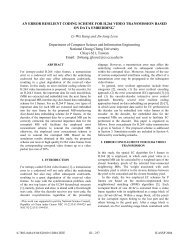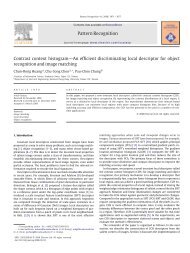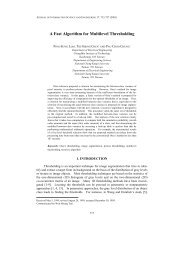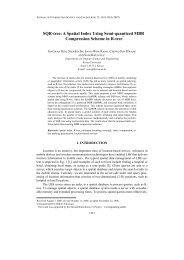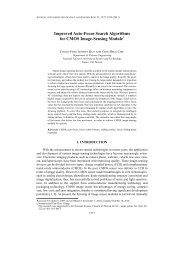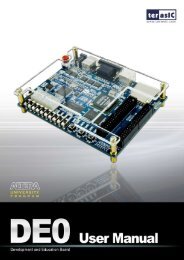Design, Implementation, and Performance Evaluation of Flash ...
Design, Implementation, and Performance Evaluation of Flash ...
Design, Implementation, and Performance Evaluation of Flash ...
Create successful ePaper yourself
Turn your PDF publications into a flip-book with our unique Google optimized e-Paper software.
FLASH MEMORY-BASED FILE SYSTEM ON CHIP<br />
both the conventional storage device <strong>and</strong> FSOC are mainly dominated by the I/O<br />
time with an increase rate <strong>of</strong> 1. Note that in Fig. 7, the results seem to be a constant<br />
value, but this is because the increase rate is relatively very small compared to the<br />
other phases.<br />
The difference is (TFSOC_parallel – Tconv_parallel) = N(TFS_FSOC – TFS_host) (recall that<br />
we assume that Tstub <strong>and</strong> Tdriver are the same). The difference in the run time is caused<br />
by the difference in executing the file system code in the host <strong>and</strong> FSOC, <strong>and</strong> the<br />
conventional storage device shows better performance. Detailed execution times<br />
occurring at each system component for this phase are depicted in Fig. 8 (a).<br />
(2) This is when application code execution time is greater than the I/O time <strong>of</strong> the conventional<br />
storage device <strong>and</strong> smaller than the I/O time <strong>of</strong> FSOC, that is, Tmedia +<br />
Ttrans ≤ Tcomp < TFS_FSOC + Tmedia + Ttrans. Here, application run time <strong>of</strong> the conventional<br />
storage device is dominated by Tcomp <strong>and</strong> the rate <strong>of</strong> increase is N. On the other<br />
h<strong>and</strong>, application run time <strong>of</strong> FSOC is still dominated by I/O time <strong>and</strong> the rate <strong>of</strong> increase<br />
is 1. Therefore, the difference in application execution time grows smaller as<br />
Tcomp increases, <strong>and</strong> eventually crosses over.<br />
In order to emphasize the crossover point, we divided phase (2) into two<br />
sub-phases, that is, phase (2.a), where the conventional storage device shows better<br />
performance <strong>and</strong> phase (2.b), where the FSOC shows better performance. In phase<br />
(2.a), Tmedia + Ttrans ≤ Tcomp < (Tmedia + Ttrans) + N/(N – 1)(TFS_FSOC − TFS_host), <strong>and</strong> the<br />
difference is N(TFS_FSOC − TFS_host) + (N – 1)((Tmedia + Ttrans) – Tcomp).<br />
In phase (2.b), (Tmedia + Ttrans) + N/(N – 1)(TFS_FSOC − TFS_host) ≤ Tcomp < Tmedia +<br />
Ttrans + TFS_FSOC, <strong>and</strong> the difference is given as N(TFS_host – TFS_FSOC) + (N – 1)(Tcomp –<br />
(Tmedia + Ttrans)). Figs. 8 (b) <strong>and</strong> (c) show the detailed execution times occurring at<br />
each system component for these two situations, respectively.<br />
(3) This is when the application code execution time is greater than the I/O time <strong>of</strong> the<br />
FSOC, that is, Tcomp ≥ Tmedia + Ttrans + TFS_FSOC ≥ Tmedia + Ttrans. Here, the application<br />
run times <strong>of</strong> both the conventional storage device <strong>and</strong> the FSOC are dominated by<br />
the application code execution time. Hence, the application run time increases proportionally<br />
to Tcomp for both devices <strong>and</strong> the rate <strong>of</strong> increase is N. The difference in<br />
the application run time between the conventional storage device <strong>and</strong> the FSOC is<br />
(Tconv_parallel – TFSOC_parallel) = N × TFS_host – TFS_FSOC. Fig. 8 (d) shows the detailed execution<br />
times occurring at each system component for this phase.<br />
In summary, FSOC performs better than the conventional storage device when the<br />
application code execution time is larger than the I/O time. This performance gain is due<br />
to the fact that parallel execution <strong>of</strong> file system code <strong>and</strong> application code is possible<br />
with FSOC. Otherwise, the conventional storage device performs better.<br />
5. PERFORMANCE EVALUATION<br />
In this section, the quantitative aspect <strong>of</strong> FSOC is evaluated through several experiments<br />
using our prototype implementation. For this purpose, the performance <strong>of</strong><br />
FSOC is compared against a conventional storage device. The conventional storage device<br />
1875




